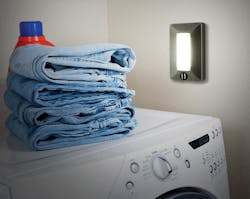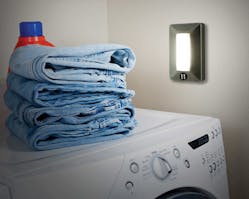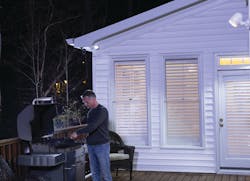Primary- and rechargeable-battery power for LED-based lighting products delivers freedom of deployment, and MAURY WRIGHT reports that more efficient LEDs make such products viable beyond portable lighting.
Think battery-powered lighting and you most likely are picturing flashlights or similarly-portable products and applications. But LED sources, mainly due to the inherent energy efficiency that continues to improve, will again be a game changer when it comes to the flexibility afforded by battery-powered lighting. Consumers may not be moving to battery power for their main household lighting, but new products can deliver far more than niche lighting needs indoors and out. Let's examine some of the trends in battery-powered solid-state lighting (SSL) and some of the latest products on the market. Our mission is both to see what has been accomplished and - equally important - to spur industry creativity with batteries.
Looking back, battery power has served a limited niche across commercial and residential lighting. We all know about LED flashlights that have totally usurped the portable lighting market. In the commercial/municipal outdoor lighting sector, solar-based systems that charge large batteries are used in area lighting installations in the US and in roadway applications in other parts of the world. We recently covered an area lighting application on a US military base. In an article on the Strategies in Light 2014 conference, we covered the broad use of solar-powered street lights in desert areas such as the United Arab Emirates.
In residential applications, the use of battery-powered lighting has been primarily focused on outdoor products such as solar-charged suspended or post-top lanterns. Such products have earned a poor reputation with solar-charged batteries not lasting through the night and complete battery failures occurring early in a product's lifetime.
Now, however, more serious lighting manufacturers are delivering battery-powered products based on both primary replaceable batteries and on rechargeable-battery technologies. Primary batteries can provide relatively long life in some applications where SSL products see sporadic usage or usage for short periods of time. Rechargeable batteries require the inconvenience of consumers having to charge yet one more device but can be a better option for lighting that is regularly used for longer periods of time.
Indoor products
Now let's discuss some of the latest battery-powered LED products. One notable line comes with the General Electric (GE) brand, although the products are from Jasco, not from mainstream lighting vendor GE Lighting. Jasco and GE have had a licensing agreement in place for some time that enables Jasco to sell certain home electrical products, consumer electronics, home automation products, security and surveillance products, and more using the GE brand.
We asked Jerry Duffy, general manager of global product management at GE Lighting, specifically about the Jasco deal, especially when it comes to lighting products. Duffy said Jasco has been a valuable GE partner and has sold quality products under the licensing agreement.
Related article & video: LEDs Magazine Highlights from LightFair – GE Lighting (VIDEO)
The GE Enbrighten products from Jasco first focused on portable battery-powered lanterns that might serve in place of a traditional gas-burning camping lantern. Now Jasco has introduced a small LED luminaire that functions in the space ranging between a night light and a wall sconce, although it can be used portably as well (Fig. 1).
The product delivers 300 lm in the battery-powered version or 400 lm in a plug-in version, so it produces enough light to do more than the typical night light. Jasco said the fixture is equivalent to a 40W lamp. The 3000K-CCT output is functionally suitable for use in a kitchen area or hallway, or relegated to a laundry room.
As is the case with many battery-powered products, Jasco refers to the product as wireless. That description is technically correct as it applies to a power source, but not in terms of wireless-based control. Still, you are probably asking, what about battery life? Jasco said in high-usage areas, the six AA-cell batteries would power the fixture for eight months. Lower-usage areas should see longer battery life.
The new Enbrighten product is styled for prominent display with a brushed nickel finish. The luminaire includes a picture-frame-type stand that allows for tabletop usage, or more typically the fixture can be wall mounted almost anywhere. Jasco offers a version with touch-based on, off, and dimming controls ($25), and a separate model with a built-in motion sensor that can automatically trigger the light ($30).
Outdoor spotlights
Now let's discuss a well-known outdoor product line from Mr Beams. The company has many versions of spotlights that operate on three D-cell batteries. The most widely-sold product is the MB360 ($25) that the company said can deliver 40 hours of life from one set of batteries. The company expects the life to be about one year in typical operation, with each light delivering 140 lm over a 400-ft2 coverage area. The product was designed mainly for safety and security applications but also for convenience in areas such as decks (Fig. 2). It can even be installed along pathways on trees and is triggered by a motion sensor, turning off 30 seconds after no motion is detected.
Recently, Mr Beams has significantly expanded its outdoor product line and had a broad set of products on display at LightFair International (LFI) this year. For example, the company is adding wireless controls in two different flavors to what has been touted as a wireless-power product line.
Some of the new products such as the MBN342 are based on a technology called NetBright that uses proprietary RF links to connect outdoor lighting fixtures in a network. NetBright supports four separate networks, each of which can have 50 luminaires on the network. When any luminaire detects motion, it triggers all of the other luminaires on its network. And all shut off after motion is last detected by any luminaire on the network. The multiple-network feature is designed, say ,to have one network on the front side of a home and another in the back.
Mr Beams has also announced spotlights with RF-based remote controls. The black MB371 and white MB370 ($40) still include motion sensors but can also be controlled via remote with the ability to override the motion sensor and to set the lights to one of three dim levels. Lights will still shut off automatically either in the absence of motion, or after one or four hours as set by the remote control. The broad outdoor product line has also been extended with higher-output products - up to 300 lm, but that performance comes with degraded battery life.
Ceiling lights
Still, it's an indoor product that may have gained Mr Beams its greatest accolades. A writer at the Wall Street Journal called the Ceiling Light the best battery-powered light for a closet.
The accolades are due to the convenience of mounting, and also the fact that the luminaire produces quality light. It's rated for 85 CRI at 3500K CCT. The output is only 100 lm, but that is plenty of light for many closet applications, although Mr Beams touts the product for many usage scenarios outside of closets. It does include motion-sensor activation.
The Ceiling Light MB980 ($25) uses four C-cell batteries. Mr Beams said expected battery life is one year or about 35 hours of usage. The fixture can detect motion anywhere within 20 ft.
Entertaining and convenience
Now we will transition to a discussion of a product based on a rechargeable battery that is designed for longer usage periods on a daily basis. The rechargeable architecture means that the luminaire can be used while plugged in although it would work tether free for a number of hours. There are a number of rechargeable products on the market, but Philips Lighting stands out as being a major lighting vendor and having brought battery power to the color-changing Hue family of products.
The Hue Go (about $100) product looks like a small bowl but includes an integrated light engine with red, green, and blue (RGB) LEDs (Fig. 3). You configure the Hue Go with a smartphone or tablet. The wireless ZigBee-based product does require a Wi-Fi-to-ZigBee bridge or gateway, as does all ZigBee-based lighting.
FIG. 3. The Hue Go provides functional and mood lighting.
Philips says the Go product has a battery life of around three hours and takes half that time to charge. Philips could certainly have increased that run time with a larger battery at the expense of size and cost. Time will tell whether consumers will find Hue Go a useful addition to their homes.
Indeed, the Hue value proposition remains a question mark. The Hue lights in general are fun without question, although Philips Lighting CEO Eric Rondolat made the point that the technology adds valuable functionality in the home in an LEDs Magazine interview. The entry price point is high, but Rondolat said it's affordable for consumers who really embrace and use the added functionality that the lights bring to a home.
Retrofitting lighting
One final concept that we will mention in the battery-powered area is retrofitting of AC-powered legacy products to use batteries and LEDs. We would not expect that such retrofits would become a mainstream concept or that major businesses would emerge around the concept. Indeed, retrofitting will be firmly in the realm of the do-it-yourself (DIY) community.
An online DIY project, however, caught our eye. Quite often, the AC power cord is a problem in interior design. New construction can place an AC outlet almost anywhere, but retrofits and redesigns are stuck with AC outlets in existing locations.
In the DIY project, the homeowner wanted to place a vintage desk lamp on furniture in the middle of a room without the obstacle of a power cord running to the wall. A small length of LED strip lighting in the lamp head combined with batteries added to the base solved the problem and delivered output judged near the equivalent of a 60W incandescent lamp (http://bit.ly/1S6NOsh).
More battery-powered options
Back to commercial products, there are far more battery-powered lighting products on the market than we can cover here. Many are still on the low-quality side and meant for specialty applications. But many can also fill a need in a much simpler manner than installing AC-powered lighting.
Retailer Costco has sold undercabinet LED light bars from a company called Megabrite, and those lights are also widely available online. The bars can be mounted with screws or even double-sided tape under kitchen cabinets, in shelving units, and in entertainment centers. A motion sensor can automatically trigger the lights.
Fulcrum Products sells a selection of battery-powered SSL products including undercabinet lights and round puck lights intended for various uses. The company also offers outdoor porch lights and pathway lights.
Right now, Costco has some LED lighting in stock from Capstone that is motion activated and can be placed in closets or other places. The mechanical design allows rough aiming of the sensor and the LEDs. Longer term, Capstone has some ideas about how to use battery-powered lights to make sure that residential lights stay on when the power goes off.
What's really exciting, however, is what is next. LEDs will allow innovative lighting products that aren't bound by a cord. And without question, the best ideas are still on the drawing board.








